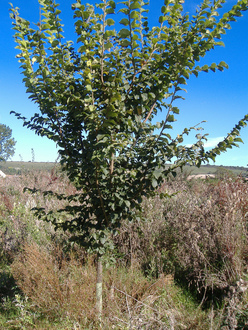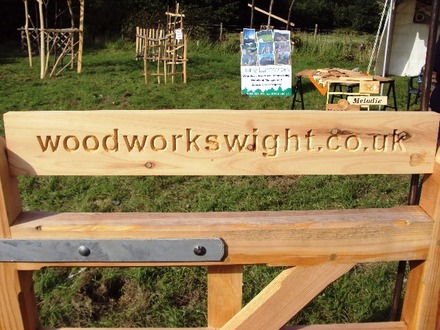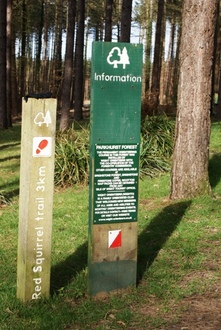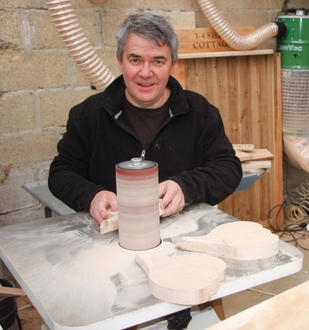Natural Enterprise and IW AONB Elms Project
31 January 2012

Elms were once the characteristic mature trees across much of the Island’s landscape but have been devastated over the past 40 years by Dutch elm disease (DED), a lethal fungal infection spread from tree to tree by bark beetles.
The loss of English and wych elms as large trees (they still survive in hedgerows) has not only changed the look of the countryside, it has also affected a wide variety of species that were dependent on them such as the scarce white-letter hairstreak butterfly.
Since the last big outbreak on the Island in the 1990’s Island 2000 Trust has distributed and planted, with the help of landowners and communities, thousands of disease resistant cultivars across the Island in an attempt to restock woods and copses and create a whole new generation of elms for the future.
Natural Enterprise and the Isle of Wight Area of Outstanding Natural Beauty Partnership are now looking to follow up on this work and think about the best policy for the future of Island elms. Thanks to funding from the AONB Sustainable Development Fund the project will:
*Identify which of the current and new resistant varieties might be appropriate for the Island , and where.
*Create a record of healthy elms within the AONB landscape, perhaps finding naturally resistant hybrids.
*Revisit some of the early elm planting schemes to check on their progress.
*Look for locations where replanting elm cultivars could support communities of lichen and other important species such as the white-letter hairstreak.
*Influence tree planting schemes across the Island to incorporate elms
*Identify partners who can help in future planting programmes
We will be conducting a survey to identify elm trees around the Island which will be launched soon. In the mean time if you have any photos of existing mature elms please send them in and let us know where they are. Send your photos to Natural Enterprise, The Innovation Centre, St Cross Business Park, Newport, PO30 5WB
or email them to Sam
sam.buck@naturalenterprise.co.uk
For more information on this project contact Sam on 01983 535884 or visit www.gifttonature.org.uk
Free, Healthy Food for the Picking!
4 November 2011
Volunteers Plant Fruitful Hedges
As part of The Tree Council’s “Hedgerow Harvest” project, Natural Enterprise will be working with local people to plant over 300m of new fruiting hedgerow at six locations around the Island later this month.
“These will grow to make new and attractive features that are good for people and good for wildlife. The hedges will at each of the sites fit in with conservation work that’s already been started but will be perfect for scrumping too!” said Ian Boyd of Natural Enterprise, “We are planning bigger fruit tree planting projects at some of these sites and the Tree Council scheme is a perfect way to get things started. Keep an eye on the Natural Enterprise website for details as the work gets underway.”
“In the past, hedges were used as larders of healthy seasonal food and apples, berries and nuts were collected as a healthy tasty supplement to the diet,” commented Margaret Lipscombe, The Tree Council’s programme director for Hedgerow Harvest. “This is a great project for anyone with an interest in food and the environment to get involved in.”
The Hedgerow Harvest project seeks to reconnect people with their heritage of free local healthy food. It builds on existing work being carried out as part of The Tree Council’s Hedge Tree Campaign and will encourage local people to access food for free on their doorstep by supporting a network of hedgerow foragers across the region who can inspire their neighbours and undertake projects in their communities.
The project is:
– promoting the use of hedgerow produce by providing advice and information on the Hedgerow Harvest website
– producing a collection of recipes collected from Tree Wardens and Tree Council members to inspire more people to collect hedgerow produce
– developing 10 demonstration hedge projects that can be accessed by interested local community and school groups
– providing advice about what to grow and how to plant and maintain a productive hedge
– producing a hedgerow harvest teachers pack with lesson plans that meet the need of key stage 3
The project will run for two years and is supported by a Local Food Grant from The Big Lottery.
For more information on this project contact Ian on 01983 535888 or email ian.boyd@naturalenterprise.co.uk
You can also visit www.naturalenterprise.co.uk
Bid for Bees!
14 September 2011
A 2011 “Let it Bee” Isle of Wight Festival t-shirt, signed by Pixie Lott, Lissie, Seasick Steve, Mike Rutherford, Plan B and more is up for auction on ebay.
All proceeds will go to the Isle of Wight’s “Let it bee” campaign run by the Gift to Nature conservation charity.
Let’s get bidding and raise more cash to save our bees.
The auction closes on Monday 19 September at 12.15 so don’t delay!
Follow this link for the item
Island Woodland Products Great Success at Wolverton Garden Fair
12 September 2011

The Island Woodland area was once again a great success at this year’s Wolverton Fair.
Organised by Danny Horne, a number of local woodsman and craftsman were on hand to display their products.
Tom Murphy and Jim Clinton from “Out of the Woods” had a number of coppiced items on display that he had made from chestnut from Parkhurst Forest.
Marcus Matthews from Redhill designs was displaying his signage made from off-cuts from his brother Peter Matthew’s timber business. Many of these signs can be seen alongside rights-of-way in the West Wight. In addition Marcus is now experimenting with a range of kitchen products made from Isle of Wight wood, and ideal for Christmas gifts.
Paul Sivell and Guido Oakley amassed a large audience as they demonstrated their chain-saw sculpting skills.
With the recent chilly weather, Danny experienced a lot of enquiries for local logs and directed buyers to this website.He said “Overall the weekend has been a huge success and an opportunity for people to see the diverse range of activities on the Island. There are now more woodlands being actively managed than there has been for a good number of years which is encouraging”.
New Woodfuel Woodland improvement grant available
27 June 2011

The Forestry Commission is offering a new grant that supports the sustainable production of woodfuel and other timber products. Work needs to meet the UK Forest Standard but the basis for support is economic rather than environmental or social.
This grant will open for applications in Summer 2011
The grant offers 60% towards the cost of work, and doesn’t take account of the timber income that results. The following main operations are supported:
Roads, tracks and other infrastructure to assist the extraction of timber from woodland. Support will be based on 3 quotes and grant paid on the production of receipted invoices.
Woodland inventory and costs associated with managing harvesting contracts. Support for this work is based on standard costs.
For more information click here
Linking the Woodchain
27 June 2011
myForest is a free service for woodland owners, forestry businesses and wood users. The website aims to support owners in mapping their woodlands, to provide inventory tools for managing them sustainably, and to provide a platform for wood marketing.
Through myForest, the Sylva Foundation aims to gather woodland inventory information. This data will contribute to an understanding of the potential productivity of woodlands to supply wood fuel, alongside the increased production of quality homegrown timber.
For further information click here
Renewable Heat Incentive (RHI) Scheme
27 June 2011
On 10 March 2011, the Government announced the details of the Renewable Heat Incentive policy to revolutionise the way heat is generated and used in buildings and homes. This is the first financial support scheme for renewable heat of its kind in the world.
At a time when many problems can be seen with relying on a rapidly changing world and continuous reliance on oil and gas, it is proposed to put in place a key foundation stone of our energy future where both carbon reduction and energy security are assured.
The Renewable Heat Incentive(RHI) policy document, sets out the detailed arrangements for this scheme, which will provide long-term financial support to renewable heat installations to encourage the uptake of renewable heat. It is aimed that the regulations underpinning this scheme to be approved by Parliament in summer 2011. The scheme will be introduced shortly thereafter.
For further information click here
Funding for the Woodland Industry
14 December 2010

In the last 18 months the Isle of Wight woodland industry has been allocated more than £137,000 of LEADER funding to help businesses boost their competitiveness, invest in forest extraction handling, processing and storage equipment and develop wood fuel technologies.
Managed by Natural Enterprise, LEADER funding is still available to farmers, growers and other rural based businesses including those involved in tourism and rural communities. People looking to set up their own forestry business are also eligible to apply.
One new business that has taken advantage of the support available is Redhill Farm Designs, run by Marcus Matthews. Using local wood and waste timber (sourced from his brother’s local business), Marcus produces bespoke signage for footpaths and house names and as well as chopping boards of various shapes and sizes.
Marcus Matthews said “Without the help of LEADER funding we wouldn’t have been able to expand the capabilities of the business. The initial outlay for the equipment was very high but we were able to obtain 50% match funding for the project. There was of course some paperwork to do, but nothing too onerous.”
To date projects which have received funding to purchase capital items include; equipment to aid wood burning stove and design work, wood sign design and production, wood chipping, timber extraction, furniture production and furniture design and manufacture.
Judi Griffin, Chairman of LEADER’s Local Action Group said “This funding should be taken advantage of especially by those land based industries which have been under invested in. We have had some great, innovative projects come through which are now being supported and we are encouraging more people to come and have a chat with us about their new possible ventures.”
RDPE LEADER funding is available to landowners and other rural based businesses to improve the economic value of forests and add value to forestry products. The applications are made on a competitive process and a maximum grant available for a single project is £50,000. Aid rates vary but are in the region of 40% – 50% and only for capital purchases.
For more information on how LEADER funding can help you or your business contact Carol Flux on 01983 535836 or visit the Natural Enterprise website
Grant News - Update
1 November 2010
Following on from the initial announcements of the Comprehensive Spending Review, the Forestry Commission has had it confirmed by our minister that the level of grants administered by the Forestry Commission under Axis 2 of the Rural Development Plan for England (RDPE)has not been altered for the remainder of the spending round which concludes in March 2014. Therefore the news is that:
1. The Forestry Commission will continue to deliver the current planned levels of woodland grants under RDPE up to the end of the 2013-2014 financial year
2. We are still accepting woodland creation applications for 2011/12, and farmers will be eligible to continue to have SPS eligibility on that land
3. We are open for other grants with 2011/12 payment year and for grants up to March 2014
4. We have a mechanism available that allows woodland owners to meet CPET Category B criteria for sustainably produced timber which includes a 10 year felling licence approval
5. We are planning to launch a Woodfuel WIG to support further roading access and specific management in under-managed woods in early 2011, owners may wish to start drawing potential projects to FC attention.
As it stands in South East England we have plenty of grants available up to 2014 in all our 6 grant types. Our 80% WIG target areas have been increased to cover all the main AONBs and the two National Parks within the south east. We are offering enhanced rates of planting grant where the new woodland provides informal public access within a Quality of Place target area and on the Isle of Wight.
Regarding bullet point 5
Grants will soon be announced which will offer owners new grants towards management in all woodland types that exhibit a lack of the appropriate levels of management and where there is clear potential to provide sustainable renewable energy for the future. This is likely to include grant towards track improvement, timber stacking, tree marking, tendering and other activity needed to present parcels of timber to the market place.
Early grant payments
It is anticipated that there is likely to be an under spend of grant this year as we are seeing owners backing out of planting schemes due to high cereal prices and because we paid a lot of claims early last spring. Therefore if you plan to undertake work this autumn on work agreed for payment after 1 April 2011, then please get your claim in early as we should be able to pay for work completed this spring out of this year’s budget, so freeing up more funds for next year.
Studio in 'Isle of Wight' Woods
26 July 2010
This year’s Studio in the Woods upheld its yearly outdoor tradition of enacting intellectual debate with chainsaws.
Over a scorching long weekend, the architectural utopia of Studio in the Woods existed fleetingly and safely at one remove from reality in the hills and valleys of the Isle of Wight. Organised this year for the first time by the new Isle of Wight Architecture Centre (IOWAC), the event continues the format started by Bath based Mitchell Taylor Workshop in 2006. A family farm of several hundred acres provided the setting, a strip of land meandering up through a sheltered valley flanked by ancient woodland to wide grassy uplands of rolling hills with panoramic views over most of the island.
All the refinements of latter-day festivals supported the efforts of some 70 students and tutors organised into five teams. Working up through the valley section, two barns were used for lectures, presentations and (surprisingly fine) dining. A “loo-city” of prefabricated shower and compost WC towers designed by Matthew Dalziel and Neil Evensen provided “glamping” class facilities. The busy mobile saw-mill converted island-grown Corsican pine trunks into construction materials and a thick carpet of sawdust.
This exemplifies the ambition of IOWAC to encourage a stronger local culture of architecture using the resources at hand as an alternative to importing materials from the mainland. The timber was sourced by Natural Enterprise, an organisation set up to foster productive links between environmental and economic initiatives on the island.
It was impressive to see how much can be achieved in two days with no bureaucracy. As such collaborations suggest, this was far from being just a bunch of hippies waving chainsaws in the woods, the event proved to be a concentrated learning experience in debating and evolving ideas and of collectively hammering together the results. It was impressive to see how much can be achieved in little more than two days by teams of a dozen people with no bureaucracy or paperwork involved – apart from the obligatory health and safety lecture.
Two evenings of lectures broadened the frame of reference beyond the folksy and included a presentation by AA tutor Shin Egashira, who made compelling use of film to describe his constructions.
According to effusive visiting critic and speaker Ted Cullinan, projects were graded on the “testosterone scale” of tonnage of wood shifted. Piers Taylor and Meredith Bowles scored highly with their enclosed box truss cantilevering impressively from a supporting tree to lift visitors into the space below the forest canopy. Newcomers Studio Weave erected a hill-top fire beacon on the axis of the valley that perfectly smoked all those who helped to build it.
The landscape held all of these projects, apart from the tree-house, within sight of each other in the same way as the fantasy rural idyll of 18th century landscape garden Stourhead. Familiar themes of environmental and land-art informed Toby Lewis’s finely detailed land pier, built as a measure of the landscape and an individual’s perception of it. Erect Architecture exploited the material character of thinly sliced green timber with a hill-side construction curled up like a giant wood shaving. The team, headed up by Gianni Botsford and Kate Darby, used mirrors to reflect spots of light on a nearby chalk escarpment at specific times of the day, the perfect alibi for some dynamic and elegant form-making.
A one-day children’s workshop was held in parallel to investigate the mythical origins of architecture, fairy houses and woodland dens. At this point it was time to return to the city and resist the urge to move in permanently to become a rambling picturesque hermit.